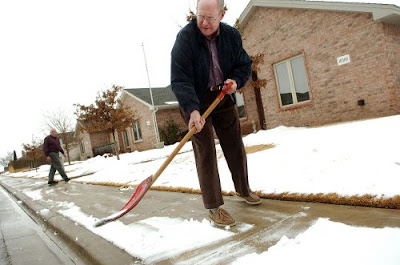By Kim Friel
Our country faced record-breaking heat waves during the 2011 summer months, but an article posted this month by the Huffington Post warns those over 50 that the winter months pose the most danger. For instance, the body’s reaction to cold weather can increase the chance of blood clots, which in turn can heighten the chances for heart attacks and strokes (Numbers 1 and 3, respectively, on the list of leading causes of death in the United States). Also, the cold weather makes it easier for respiratory diseases to be transmitted, and Huffington Post says the winter brings the most severe strains of these diseases.
The following are six specific threats the winter months bring to those over 50:
1. Snow Shoveling: According to studies done by The New England Journal of Medicine and the Clinical Research in Cardiology journal, shoveling snow can rupture plaque build-up in the coronary arteries, causing heart attacks, particularly in those with a family history. If you must shovel yourself out of snow, consider doing it earlier when the snow is lighter and make sure to take a break so you don’t over exert yourself.
2. The Flu: As stated earlier, the deadliest strains of respiratory diseases spread during the winter months. Avoid catching the flu by getting a flu shot. “People aged 65 and over and people with long-term health conditions including diabetes and kidney disease are particularly at risk,” says Huffington Post. More information on those at a higher risk of flu complications can be found at www.Flu.gov.
3. Indoor Cold: Sadly, 20% of exposure-related winter deaths occur within the home. If the cost of heating your home is an issue, set the temperature at 65 degrees during the day and 60 degrees at night to conserve fuel. If that plan does not fit your budget, contact your State for more information about the Low Income Home Energy Assistance Program (LIHEAP), found online at http://www.acf.hhs.gov/programs/ocs/liheap/index.html.
4. Carbon Monoxide: According to The Home Safety Council, a national nonprofit organization dedicated to preventing home-related injuries, two-thirds of American households use fuel-burning appliances during the winter that pose carbon monoxide risks. These include gas fireplaces, wood stoves and kerosene heaters. Carbon monoxide is an odorless gas that can cause sudden poisoning and even death if it is not properly ventilated. The first way for families to protect themselves is to install a carbon monoxide monitoring device into their home. Having these devices in your home is just as important as having smoke detectors and they can be found for less than $50. Inspect fireplaces to ensure chimneys are properly ventilated. Do not leave the engine of your vehicle running in an enclosed space such as a garage. Never attempt to heat your home using gas ranges, ovens, lanterns or portable camping stoves.
5. Automobiles: About 70% of wintertime deaths occur in automobiles, according to The Northeast States Emergency Consortium (NESEC), a nonprofit all-hazards emergency management organization. This statistic is not solely based on auto accidents, but also includes being stranded in a vehicle during a snow storm. If your car is stuck somewhere with no help in sight, stay in the car. Display a sign on the outside of the car, whether a brightly colored cloth on the radio antenna or by raising the car’s hood, in order to get the attention of a passerby. Run the engine every hour for about ten minutes you will be able to keep warm until help has arrived. If your car is dead, find anything in your car to keep you warm. This could include things such as your floor mats or road maps you have laying around—anything will help sustain the warmth!
6. Hypothermia: People age 65 and older are more vulnerable to hypothermia and certain medical conditions and medications can interfere with the body’s ability to regulate temperature, says the Mayo Clinic. Do not travel during a storm watch or warning to avoid getting stranded during a snow storm. Seek shelter immediately if you are stranded; but, do not attempt to get help if assistance is not visible within 100 feet (it is easy to become disoriented during a snow storm).
These six specific winter related problems are especially likely to affect those over 50 years old, so be aware and especially, cautious.
FOR MORE INFORMATION FROM PHIL CANNELLA, TUNE IN TO THE CPR SHOW, EVERY SATURDAY 11AM-1PM. LISTEN LIVE




